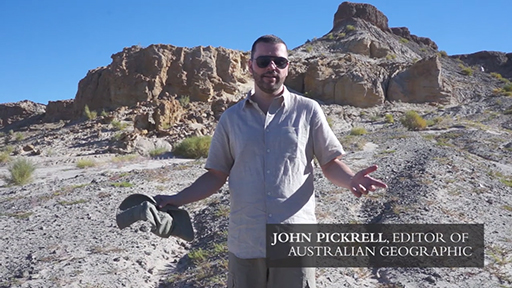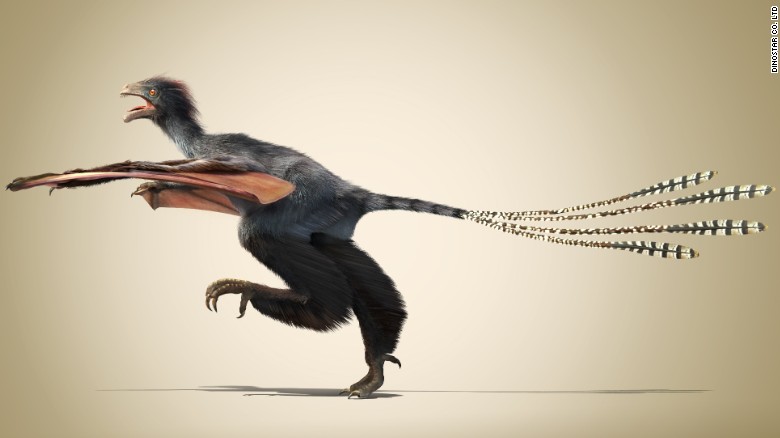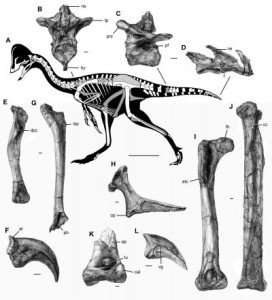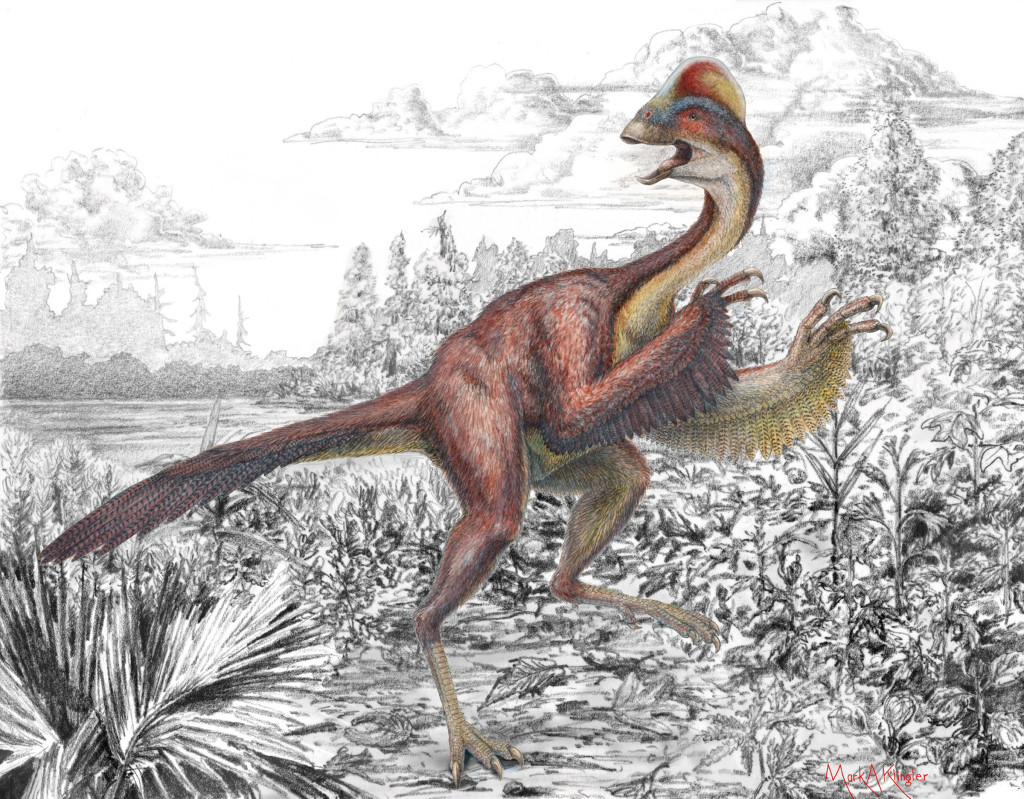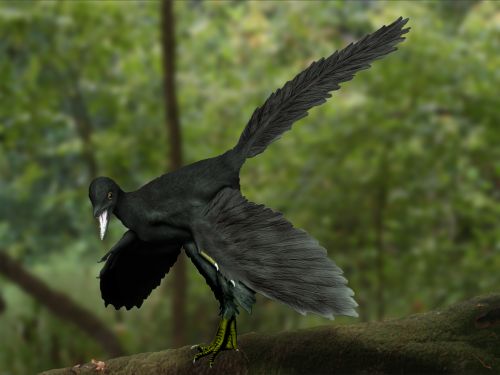In September 2016 eight Australians and ten Mongolians set out into the remote Gobi Desert to hunt for dinosaurs. Watch the full 10-minute film here.
John talks to ABC News 24 about a new American T. rex relative, and all of the incredible diversity in the wider tyrannosaur family. Was Lythronax a truly terrifying predator?
John talks to ABC News 24 about an ancient dinosaur stampede at Lark Quarry, Queensland. It was the inspiration for the stampede scene in the Jurassic Park movie, but did it actually happen?
Yi qi – China, Late Jurassic (160 million years ago), described 2015
This astonishing, 60-cm long dinosaur left experts gobsmacked when it was announced in April.
A single fossil reveals that its very long fingers had a membrane of skin stretched between them, and attached to its body. This gave it wings akin to those of a bat, as well as a body covered in downy fluff, and ribbon-like feathers on its tail. Xi qi (‘ee-chee’) means ‘strange wing’. (Image credit: Dinostar Co. Ltd)
VIDEO: Birds evolved from dinosaurs – but it wasn’t a smooth transition. Plenty of creatures tried different ways to get into the air, such as this newly discovered species, unearthed in China’s Liaoning province. This pigeon-sized animal had elongated fingers that held a membrane wing, more like a bat than a bird. In the Nature Video below, experts look at what makes this fossil so special, and consider what this dinosaur may have looked like (Credit: Nature Video).
Anzu wyliei – United States, Late Cretaceous (66 million years ago), described 2014
From the Hell Creek formation of the Dakotas, Anzu has been described by the Smithsonian Institution and Carnegie Museum scientists who found it as the ‘chicken from hell’ and a cross between an emu and a lizard. Only the second feathered dinosaur ever discovered in the Americas, this omnivorous oviraptorosaur is from the very end of the dinosaurs’ reign. Anzu (AHN-zoo) is the name of a bird-like deity from Sumerian mythology, while wyliei honours Wylie J Tuttle, the son of a museum donor.
I stopped by for a chat last night about Flying Dinosaurs with Scott Bevan and Laetitia Lemke on ABC News 24.
Archaeopteryx, the ‘first bird’, has fascinated people since the first mostly complete specimen was dug out of a quarry in Bavaria in 1861.
Along with a number of other dinosaurs and early birds, researchers have now been able to look at the microstructural features of fossilised feathers of the animal, and determine that its plumage was most likely glossy black with some white dappling – think something like a magpie or raven.
The image above, created by palaeoillustrator Nobu Tamura, is based on a 2012 study from Brown University that looked at a single feather to determine it had been black and iridescent.
 Another study in 2013, from Phillip Manning’s team at the University of Manchester, used X-rays to look at Archaeopteryx‘s entire plumage and showed that there was dappling and patterning too, and the feathers may have been partly white or lightly coloured with dark tips (see illustration, left).
Another study in 2013, from Phillip Manning’s team at the University of Manchester, used X-rays to look at Archaeopteryx‘s entire plumage and showed that there was dappling and patterning too, and the feathers may have been partly white or lightly coloured with dark tips (see illustration, left).
Co-author Roy Wogelius told reporters: “This work refines our understanding of pigment patterning in perhaps the most important known fossil. Our technique shows that complex patterns were present even at the very earliest steps in the evolution of birds.”
Nevertheless, new scientific findings don’t stop people routinely using old and inaccurate illustrations, such as this one, published today by the BBC.
To learn more about how Ryan Carney and his team at Brown University determined the colour of an Archaeopteryx feather, watch the video below.
Just 11 or so fossils of Archaeopteryx have been found, the earliest being a single feather.
Epidexipteryx hui
China, Mid- to Late Jurassic (152–168 million years ago), described 2008
This odd pigeon-sized dinosaur found in China’s Inner Mongolia Province had a downy covering of fuzz for insulation and four long, ribbon-like feathers that emerged from its tail and were probably used for display. Weirder still were Epidexipteryx’s incredibly long fingers – the third finger was half the length of its entire body. These strange features suggest it scrambled around in the trees, possibly using the long digits to skewer fat grubs in tree holes and crevices, just as the aye-aye of Madagascar does today. Epidexipteryx (EPP-ee-deks-IP-tuh-riks) hui means ‘Hu’s display feather’ and the species was named in honour of palaeontologist Hu Yaoming.
Video courtesy of the BBC Earth YouTube Channel and originally from the fantastic Planet Dinosaur documentary series.
Gigantoraptor erlianensis
Mongolia, Late Cretaceous (80–95 million years ago), described 2007
This species was discovered accidentally by Xu Xing while he was shooting a TV show in Inner Mongolia in 2005. Filming had to stop because he was so excited. The largest member of the parrot-beaked oviraptorosaur group – at 8 metres long and 4 metres tall – it was 35 times the size of the next largest member of the group. It has not been found directly with feather impressions, but is assumed to have had feathers because of its close relationship with known feathered species. It was the largest known animal ever to have had feathers until Yutyrannus was described in 2012. Massive nests and eggs likely to have belonged to Gigantoraptor have been found in similar Late Cretaceous deposits in Mongolia and China. At 45-centimetres long, the eggs are the largest known dinosaur eggs. Gigantoraptor (ji-GAN-to-RAP-tor) erlianensis means ‘giant plunderer from the Erlian Basin’.
Video courtesy of the BBC Earth YouTube Channel and originally from the fantastic Planet Dinosaur documentary series.
Microraptor gui
China, Early Cretaceous (110–120 million years ago), described 2003
Hundreds of specimens of several similar species of this four-winged flier have been found in Liaoning. Studies revealed these animals had feathers that were blue-black with an iridescent sheen, similar to a crow, and serrations in their teeth suggest that fish were part of their diet. Three species have been named (M. gui, M. zhaoianus and M. hanqingi), but they may yet be shown to represent variation within a single species. Microraptor (MY-crow-RAP-tor) means ‘tiny plunderer’. The species was named in honor of Chinese paleontologist Gu Zhiwei.
Video courtesy of the BBC Earth YouTube Channel and originally from the fantastic Planet Dinosaur documentary series.
Sinornithosaurus millenii
China, Early Cretaceous (120–125 million years ago), described 1999
Around 1 metre long when fully grown, Sinornithosaurus was a small predatory dromaeosaur related to Deinonychus and Velociraptor. The first specimen was discovered by a team including Xu Xing in 1999 and became the fifth feathered species of dinosaur found in western Liaoning. The fossils have downy feathers covering much of the body and more-developed quills on the arms and tail. A 2009 study proposed that the species may have been venomous (as seen in the video above), injecting poison via fangs in a similar way to a snake, but this has not been widely accepted. A second species, S. haoiana, was described in 2004. Sinornithosaurus (SINE-or-nith-o-SOR-us) milleni means ‘millennium Chinese bird lizard’.
Video courtesy of the BBC Earth YouTube Channel and originally from the fantastic Planet Dinosaur documentary series.
